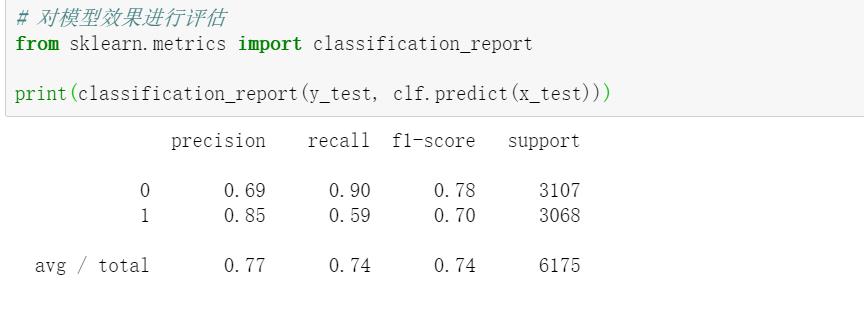情感分析-机器学习
Posted TIME0101
tags:
篇首语:本文由小常识网(cha138.com)小编为大家整理,主要介绍了情感分析-机器学习相关的知识,希望对你有一定的参考价值。
情感分析-机器学习
指路链接:胡言欢
# 导入库
import pandas as pd
# 读入原始数据集
dfpos = pd.read_excel("购物评论.xlsx", sheet_name = "正向", header=None)
dfpos['y'] = 1
dfneg = pd.read_excel("购物评论.xlsx", sheet_name = "负向", header=None)
dfneg['y'] = 0
df0 = dfpos.append(dfneg, ignore_index = True)
df0.head(10)

import jieba
安装“jieba”教程:anaconda安装jieba
# 分词和预处理
cuttxt = lambda x: " ".join(jieba.lcut(x)) # 这里不做任何清理工作,以保留情感词
df0["cleantxt"] = df0[0].apply(cuttxt)
df0.head()

from sklearn.feature_extraction.text import CountVectorizer
countvec = CountVectorizer(min_df = 5) # 出现5次以上的才纳入
wordmtx = countvec.fit_transform(df0.cleantxt)
wordmtx

# 按照7:3的比例生成训练集和测试集
from sklearn.model_selection import train_test_split
x_train, x_test, y_train, y_test = train_test_split(
wordmtx, df0.y, test_size=0.3) # 这里可以直接使用稀疏矩阵格式
x_train[0]

# 使用SVM进行建模
from sklearn.svm import SVC
clf=SVC(kernel = 'rbf', verbose = True)
clf.fit(x_train, y_train) # 内存占用可能较高
clf.score(x_train, y_train)

# 对模型效果进行评估
from sklearn.metrics import classification_report
print(classification_report(y_test, clf.predict(x_test)))

clf.predict(countvec.transform([df0.cleantxt[0]]))[0]
# 模型预测
import jieba
def m_pred(string, countvec, model) :
words = " ".join(jieba.lcut(string))
words_vecs = countvec.transform([words]) # 数据需要转换为可迭代格式
result = model.predict(words_vecs)
if int(result[0]) == 1:
print(string, ":正向")
else:
print(string, ":负向")
comment = "外观美观,速度也不错。上面一排触摸键挺实用。应该对得起这个价格。当然再降点大家肯定也不反对。风扇噪音也不大。"
m_pred(comment, countvec, clf)

comment = "作为女儿6.1的礼物。虽然晚到了几天。等拿到的时候,女儿爱不释手,上洗手间也看,告知不好。竟以学习毛主席来反驳我。我反对了几句,还说我对主席不敬。晕。上周末,告诉我她把火鞋和风鞋拿到学校,好多同学羡慕她。呵呵,我也看了其中的人鸦,只可惜没有看完就在老公的催促下睡了。说了这么多,归纳为一句:这套书买的值。"
m_pred(comment, countvec, clf)

仅限学习使用,侵权删

以上是关于情感分析-机器学习的主要内容,如果未能解决你的问题,请参考以下文章